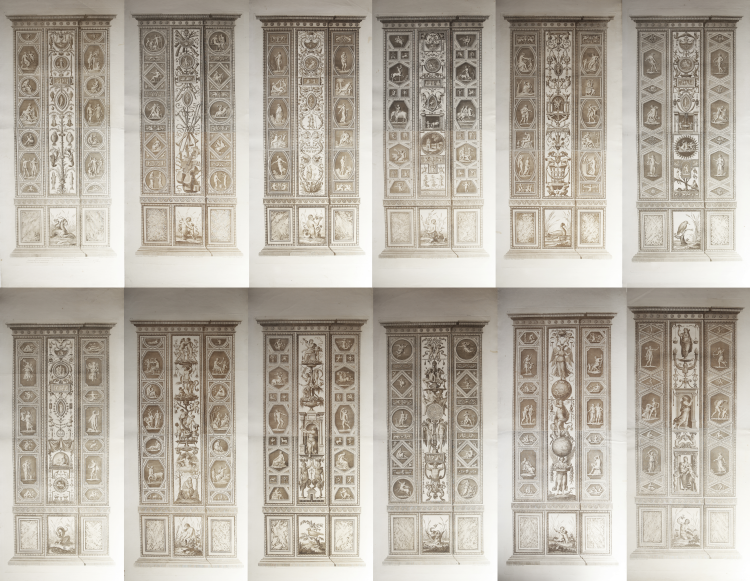















| Reference: | S30002 |
| Author | Giovanni VOLPATO |
| Year: | 1774 ca. |
| Measures: | - x - mm |














| Reference: | S30002 |
| Author | Giovanni VOLPATO |
| Year: | 1774 ca. |
| Measures: | - x - mm |
A complete series of 12 etchings, 1774/6, signed and dated at lower right.
Magnificent works, printed on contemporary laid paper with “shield with lily” watermark (if present), with wide margins, untrimmed, in excellent condition.
The famous series of the Logge of Raphael, bearing the names of Giovanni Volpato and Giovanni Ottaviani, has been realized between 1772 and 1776; the process of realization was quite long, due to the proportion of the work.
This series, which made Volpato quite famous in the Roman artistic environment of his time, is the first work that represents, minutely and completely, the pillars decorations of the Loggias painted by Raphael.
Three volumes were published between 1772 and 1776, as the result of the cooperation of the painter Gaetano Savorelli, the architect Pietro Camporesi and the engraver Giovanni Ottaviani for the first part; in 1772 Ludovico Teseo and Volpato joined them and signed the plates of the third part, the one depicting the pillars. To work on this series, Volpato, who became in a way the project manager, moved to Rome, very likely upon pope Clement XIV request (1769-1774).
Volpato’s plates, engraved between 1774 and 1776 together with Teseo who worked on the relieves, represent quite freely the twelve counter pillars of the Loggia. The scarce visibility of the lower part of the fresco brought the artist to integrate the missing parts with fictitious elements, as in the decorations of some pillars taken from the tapestries in the Vatican. Nevertheless, this did not affect the immediate and huge echo the collection had, for it represented an important figurative repertoire from which many other artists could draw inspiration and it gave a remarkable contribution to the circulation of the grotesque themes of the Neoclassical period.
A few print proofs with contemporary colour are known; they have been printed with a more delicate brown/bister ink, like the ones we present hereby, and are far more rare.
Beautyful set, in excellent condition.
|
Giorgio Marini, Volpato, pp. 187/198; Pezzini in "Raphael Invenit" pp. 105/6, 36/45. Dimensioni 480x1060 ognuna.
|
Giovanni VOLPATO (Angarano di Bassano, 1740 - Roma, 1803)
|
Italian engraver. In 1760 he entered the famous copperplate printworks of Giambattista Remondini in Bassano and, under the guidance of Antonio Baratti, learnt the art of engraving and etching. During this early period he engraved, signing himself Jean Renard, four Rustic Capricci after Giovanni Battista Piazzetta, the Four Parts of the World after Jacopo Amigoni, the Four Ages of Man after Andrea Zucchi and the portrait of Giambattista Morgagni. On the invitation of Francesco Bartolozzi, who had noted his talent during a visit to Bassano, he moved to Venice in 1762 and was thus able to refine his technique while maintaining his connection with the Remondini concern as a technical consultant and commercial adviser.
|
|
Giorgio Marini, Volpato, pp. 187/198; Pezzini in "Raphael Invenit" pp. 105/6, 36/45. Dimensioni 480x1060 ognuna.
|
Giovanni VOLPATO (Angarano di Bassano, 1740 - Roma, 1803)
|
Italian engraver. In 1760 he entered the famous copperplate printworks of Giambattista Remondini in Bassano and, under the guidance of Antonio Baratti, learnt the art of engraving and etching. During this early period he engraved, signing himself Jean Renard, four Rustic Capricci after Giovanni Battista Piazzetta, the Four Parts of the World after Jacopo Amigoni, the Four Ages of Man after Andrea Zucchi and the portrait of Giambattista Morgagni. On the invitation of Francesco Bartolozzi, who had noted his talent during a visit to Bassano, he moved to Venice in 1762 and was thus able to refine his technique while maintaining his connection with the Remondini concern as a technical consultant and commercial adviser.
|